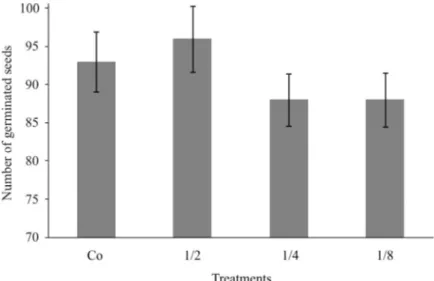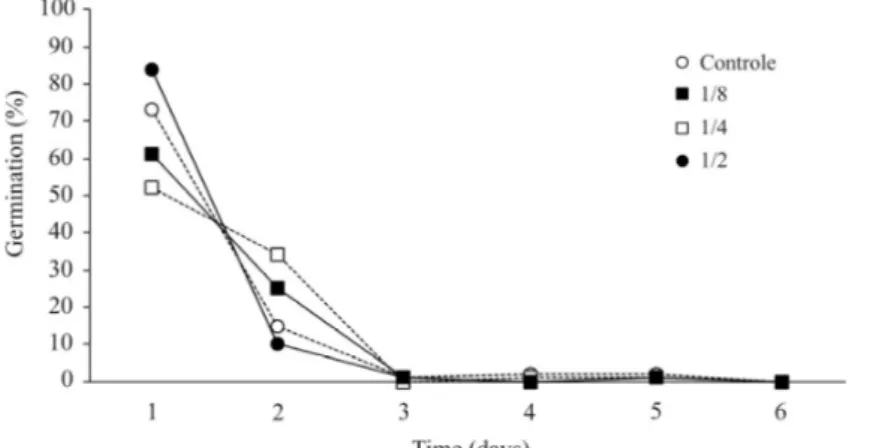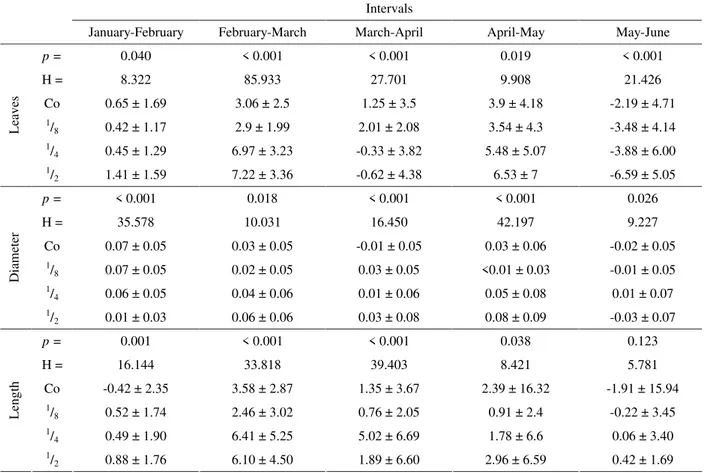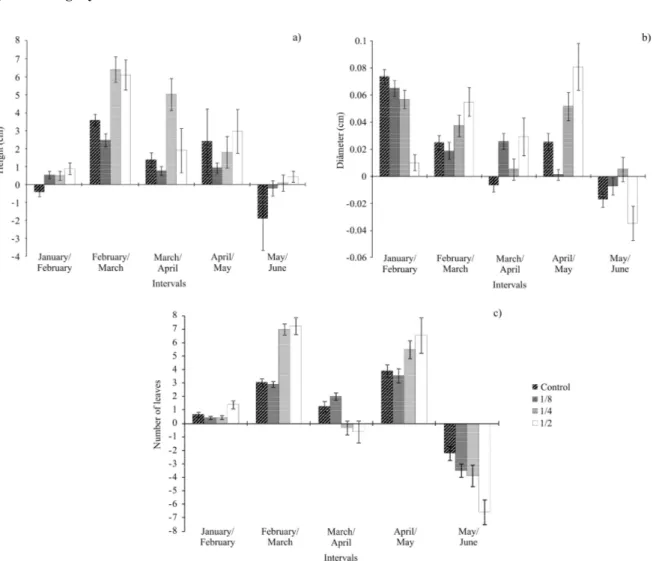227 Cotyledon integrity on ACOTYLEDON INTEGRITY ON Anadenanthera colubrina... nadenanthera colubrina (VELL.) BRENAN
(FABACEAE - MIMOSOIDEAE) GERMINATION AND EARLY ESTABLISHMENT Hisaias de Souza Almeida1, Anne Priscila Dias Gonzaga2, Helaine de Sousa3,
Yule Roberta Ferreira Nunes4, Henrique Nery Cipriani5 (received: September 16, 2009; accepted: March 31, 2010)
ABSTRACT: Despite the major ecological and economical relevance of forest species, little is known about their seedling establishment and seed germination, as well as the damage effects to seeds at these stages. This work aimed to assess the effects of partial cotyledon loss on the seed germination and early seedling establishment of Anadenanthera colubrina. Therefore, whole (control) and split seeds (with 1/
8, 1/4, and ½ of their size cut) were evaluated. The seeds were then germinated and the early growth of seedlings was assessed. The treatments had no effect on seed germination, however, they influenced seedling survival and establishment. The highest mortality and growth reduction values were obtained with the most severe cotyledon removal. This indicates that the tegument and the partial cotyledon loss do not represent a barrier against seed germination. However, considerable damages may be detrimental to establishment and survival of A. colubrina seedlings.
Key words: Seedlings, seeds, Red-Angico.
INTEGRIDADE DOS COTILEDONES NA GERMINAÇAO E NO DESENVOLVIMENTO INICIAL DE Anadenanthera colubrina (VELL.) BRENAN (FABACEAE - MIMOSOIDEAE)
RESUMO: Apesar da grande importância ecológica e econômica das espécies florestais, pouco se sabe sobre a germinação e o estabelecimento de suas plântulas, bem como os efeitos dos danos à semente para estas etapas. Neste sentido, conduziu-se este trabalho, com o objetivo de avaliar os efeitos da perda parcial dos cotilédones de Anadenanthera colubrina, na germinação das sementes e no desenvolvimento inicial de suas plântulas. Para isso, foram avaliadas sementes inteiras e sementes seccionadas nas proporções: controle; ¹/8 da semente; ¹/4 da semente e ½ da semente. Posteriormente, as sementes foram colocadas para germinar e avaliado o estabelecimento das plântulas formadas. Os tratamentos não influenciaram na germinação, todavia influenciaram no estabelecimento e sobrevivência das plântulas. Os valores de crescimento e mortalidade foram maiores para os tratamentos com cortes mais severos. Isso indica que a perda de parte dos cotilédones não constitui uma barreira à germinação das sementes, no entanto, danos consideráveis podem prejudicar o estabelecimento e a sobrevivência das plântulas de A. colubrina.
Palavras-chave: Plântulas, sementes, Angico-Vermelho.
1Biologist, PhD Candidate in Forest Engineering – Laboratório de Dendrologia e Ecologia de Florestas Tropicais – Deptartamento de
Ciências Florestais – Universidade Federal de Lavras – Cx. P. 3037 – 37200-000 – Lavras, MG, Brazil – hisaias37@gmail.com
2Biologist, PhD Candidate in Forest Science – Laboratório de Dendrologia – Departamento de Engenharia Florestal – Universidade de
Brasília – Cx. P. 04357 – 70919-970 – Brasília, DF, Brazil – diaspri@gmail.com
3Forest Engineer – Laboratório de Dendrologia e Ecologia de Florestas Tropicais – Deptartamento de Ciências Florestais – Universidade
Federal de Lavras – Cx. P. 3037 – 37200-000 – Lavras, MG, Brazil – helainedesousa@gmail.com
4Biologist, Dr. Professor – Laboratório de Ecologia e Propagação Vegetal – Departamento de Biologia Geral – Universidade Estadual de
Montes Claros – Cx. P. 126 – 39401-089 – Montes Claros, MG, Brazil – yule.nunes@unimontes.br
5Forest Engineer, Masters student of the Soil and Plant Nutrition Program of Universidade Federal de Viçosa/UFV – Av. Peter Henry
Holfs s/n – Campus Universitário – Viçosa, MG – 36570-000 – hncipriani@hotmail.com 1 INTRODUCTION
Germination and establishment are among the most critical stages of plant life cycle, in which they are prone to strong interference from the environment and their own metabolic limitations (BEWLEY, 1997; BEWLEY & BLACK, 1994; KOSZO et al., 2007). In order to overcome these difficulties, species adopt many strategies to guarantee their permanence in the community. Such strategies may vary with the position which the species occupies in the
forest profile (SWAINE & WHITMORE, 1988) and the environmental characteristics of the vegetation type where the species usually occurs.
228 ALMEIDA, H. de S. et al.
MONTEIRO-FILHO, 2007; CARVALHO & NAKAGAWA, 1988) and establishment. Therefore, in some cases, natural predators interact with microorganisms and climatic changes, acting as natural scarification agents (CARVALHO & NAKAGAWA, 1988). On the other hand, when the production of high quantities of seedlings is interesting, artificial tegument scarification techniques may be used to break seed dormancy (SCALON et al., 2007), causing tegument rupture or weakening, allowing and/or promoting germination (BEWLEY, 1997).
Although tegument scarification may have positive effects, breaking seed dormancy, for instance, negative effects on population density due to natural (BARTIMACHI et al., 2008) and artificial (FONSECA & PEREZ, 2003) scarification have also been reported. In this regard, deep or superficial damages in the seed can act in different ways, promoting or hindering germination and, subsequently, the seedling establishment. Nevertheless, the effects of seed rupture by natural (e.g. predators) or artificial (e.g. mechanical scarification methods) agents on the germination and establishment of native species are still largely unknown.
Anadenanthera colubrina (Vellozo) Brenan belongs to the Fabaceae – Mimosoideae family (THE ANGIOSPERM PHYLOGENE GROUP - APG, 2003). It is an autochoric tree species, whose individuals may reach more than 20 m high and 80 cm DBH (diameter at breast height or 1.3 m above ground).
Anadenanthera colubrina is light-demanding and often occupies the canopy of seasonal forests. It produces long coriaceus fruits, with size ranging from 20 to 30 cm (MARTIUS et al., 1876), containing about 10 to 15 rounded brown thin-coated seeds.
According to Prado (2000) and Prado & Gibs (1993) the species has wide distribution in South America and, among other 32 species, allows inferring about the distribution of deciduous forests on the continent and the “dry diagonal” formation, which links the Brazilian Caatinga to the south-western Bolivia.
The species is largely used in pasture reforestation and slat, packaging, fence stake, firewood and good-quality coal production (CARVALHO & VIEIRA, 1994). It is also planted in degraded areas and has many uses in popular medicine and in timber industry (MONTEIRO et al., 2005; RODRIGUES et al., 2007).
Within this context, this study aimed to evaluate the effects of partial tegument and cotyledon removal on Anadenanthera colubrina (Vellozo) Brenan seed
germination and seedling establishment. Therefore, the following hypotheses were tested: i) little cotyledons and tegument area loss positively influence germination, not interfering with seedling establishment, conversely to significant cotyledon loss; and ii) mortality increases along with cotyledon area loss.
2 MATERIAL AND METHODS
For this study, in November 2004, dark brown or near-dehiscence closed fruits of ten donor trees located at the State University of Montes Claros – UNIMONTES (16º43’16,49"S and 43º52’38,59"O) campus and at Guimarães Rosa Municipal Park (16º44’05.40"S and 43º52’59.28"O) were collected. The fruits were stored in plastic bags and then screened at the Ecology and Plant Propagation Lab of UNIMONTES. During screening, 400 seeds with entire morphology, identified by color and absence of surface deformations, pathogens, predation damages and abortion, were selected.
The seeds were then submitted to cut treatments, consisting in reduction of seed length in the following proportions: (1) , approximately 12.5% of the seed, (2) ¼, approximately 25% of the seed, (3) ½, approximately 50% of the seed and (4) control treatment, consisting of whole seeds. The cuts were made on the side opposite to the hilum. The purpose was to partially remove cotyledons and tegument, avoiding direct damage to embryo axis structures (VIDAL & VIDAL, 1992).
Subsequently, the seeds were distributed in 40 plastic germination boxes with 10 seeds each, being 10 boxes per treatment. At first, the seeds were moistened with 20 ml of distilled water, being rehydrated when necessary during the assessment periods. In order to keep humidity within the boxes, the seeds were placed on a filter paper, which was on a thin layer of foam (0.5 cm). Both materials were sterilized.
The germination boxes were marked according to the treatments and placed in a germination chamber with four fluorescent lamps, 12-hour photoperiod and temperature varying between 20 (no light) and 30ºC (full light). The experiment was evaluated punctually and daily for 15 days. The seeds that had shown radicle protrusion were considered germinated.
229 Cotyledon integrity on Anadenanthera colubrina...
greenhouse, where they received water twice every day without any other alteration regarding environmental factors (relative humidity, temperature, light, etc.).
During January-June 2005 period, the seedling growth was assessed monthly, starting one week after planting. The measured parameters were: (i) the total height, measured from the seedling base, at ground level, to the seedling apex; (ii) the diameter at ground level (DGL); and (iii) the number of leaves.
An analysis of variance (ANOVA) (ZAR, 1996) was made to verify the partial cotyledon loss influence on seed germination. The total number of germinated seeds per sampling unit (germination boxes) was transformed by the equation (1), where: Gi is the proportion of seeds
germinated in the box “i”; ni is the number of seeds
germinated in the box “i” until the end of the experiment
and N is the total number of seeds contained in the box at the beginning of the experiment.
N n Arcsen
G i
i (1)
In order to test whether partial tegument and cotyledon loss influenced on the late seedling development, the total seedling growth was calculated by sampling unit (seedling), Dti mf mi, i.e. the total
development measure (Dti) of a given measured parameter
(height, DGL and the number of leaves) was obtained by
subtracting the first measure value (mi) from the last
measure value (mf ). Similarly, the monthly development
(Dmi), with regard to the measured parameters, was
obtained from the difference between the values measured in a given month (ma) and the previous month (ma 1), i.e.
1
a a
i m m
Dm .
Afterward, the total and the monthly seedling development, the growth and other assessed parameters were compared between treatments by the Kruskal-Wallis test, given the data non-normal distribution (ZAR, 1996), established by the Shapiro-Wilk’s W test. The seedling establishment analysis was made using only seedlings that survived until the end of the experiment. In addition, a chart for dead seedling distribution, counted during the monthly assessments, was prepared for each treatment.
3 RESULTS AND DISCUSSION
No significant differences were found between the cut treatments in the germination of Anadenanthera colubrina seeds (F=1.153; p=0.341; N=400). Despite the statistic similarity, the ¼ and 1/
8 treatments showed a lower number of germinated seeds compared to the control and ½ treatments (Figure 1). The great similarity between the control and the ½ treatments allows inferring that the tegument represented no hindrance to seed germination. Moreover, unlike expected, partial tegument and cotyledon loss did not prove to be a limiting factor for seed germination, demonstrating that the embryo develops well even with considerable reduction (50%) of its coating and reserve tissues.
Figure 1 – Number of germinated Anadenanthera colubrina seedsafter partial tegument and cotyledon removal.
The A. colubrina seed germination occurred fairly rapidly, with approximately 67% (270) of the seeds already germinated at the first day’s end (Figure 2). Five days after the beginning of the experiment, the number of seeds with issued radicle totaled 91.25% (365) of the seeds submitted to the germination process. These results confirm primary dormancy absence in A. colubrina seeds.
Similarly to the germination, the largest number of dead seedlings was observed in the beginning of the evaluation period, right after seedling planting and the beginning of their establishment (Figura 3). One hundred and three seedlings had already died before the first measurement was made, resulting in 79% of the 131 mortalities observed during the establishment stage.
The dead seedling proportion increased towards the most severe treatments (seeds cut to the smallest sizes). In this regard, the largest number of dead seedlings was observed in the ½ treatment, about 51% (49) between seedling planting and the first measurement and 62% (59) by the end of the experiment (Figure 3). From the second month of evaluation on, the mortality values remained relatively stable, showing no defined patterns between treatments.
The main cotyledon function is to provide nutrition to seedlings early in their development (BUCKERIDGE et al., 1992; BUCKERIDGE & REID, 1996). Therefore, total or partial cotyledon removal can hinder seedling establishment, especially during the period immediately after planting, when the seedlings are in process of adaptation.
Figure 2 – Daily germination percentage of Anadenanthera colubrina seeds after partial tegument and cotyledon removal.
Figura 2 – Percentagem de germinação diária de sementes de Anadenathera colubrina, após remoção parcial do tegumento e dos cotilédones.
Figure 3 – Mortality of Anadenanthera colubrina seedlings during the initial establishment period and after partial tegument and cotyledon removal.
231 Cotyledon integrity on Anadenanthera colubrina...
Hence, the cotyledon removal and other similar factors, such as pathogenic fungi and bacteria infestation in embryo tissues, may have provided the high post-germination mortality observed in this study, as observed by Oliveira et al. (2003) in Peltophorum dubium (Spreng.) Taub. seeds and Dhingra et al. (2002) in A. colubrina seedlings.
Regarding the plant growth, i.e. the difference between the last and the first measures (Dti mf mi),
significant differences were observed in stem height (H = 59.360; p<0.001; N=234), diameter (H=36.919; p<0.001; N=234) and the number of leaves (H=17.683; p<0.001; N=234) among treatments. The highest diameter and height values were found in the ¼ treatment (height - = 13.76 ± 8.83 cm; diameter - = 0.16 ± 0.06 cm) and 1/
2 treatment (height - = 12.27 ± 10.35 cm; diameter - = 0.14 ± 0.09 cm) (Figure 4 A, B). However, the pattern observed for the
number of leaves differed from the other parameters, since the control treatment was similar to the ½ treatment but higher than the 1/
8 treatment (Figure 4 C). On the other hand, the ¼ treatment ( = 8.69 ± 5.30 cm) showed the highest number of leaves, in addition to the highest diameter and height values.
With regard to the monthly growth (Dmi ma ma 1), no clear patterns were observed for the growth in height, diameter and number of leaves of A. colubrina, but there was a clear tendency that the seedlings from the ¼ and ½ treatments grew more than the others, although control treatment seedlings had showed prominent height in the last two intervals. Moreover, significant differences were found between the cut treatments for the three parameters and all intervals evaluated, except for total height in the last interval (May-June), which showed similar growth among all treatments (Table 1).
Figure 4 – Final growth of Anadenanthera colubrina seedlings after partial tegument and cotyledon removal: a – total stem height, b – diameter at ground level and c – number of leaves.
Figura 4 – Crescimento final das plântulas de Anadenanthera colubrina, após remoção parcial do tegumento e dos cotilédones:a – altura total do caule; b – diâmetro a altura do solo; c – número de folhas.
x
x
x x
232 ALMEIDA, H. de S. et al.
Table 1 – Kruskal-Wallis (H) mean test between cut treatments used in Anadenanthera colubrina seeds for each evaluation interval and growth parameter: number of leaves, diameter and stem length. The mean and standard deviation ( DP) are also presented for each treatment and time interval. Co – whole seeds; ½; ¼ e ¹/8.
Tabela 1 – Teste de médias Kruskal-Wallis (H), utilizado entre os tratamentos de corte em sementes de Anadenanthera colubrina, para cada intervalo de avaliação e parâmetro de crescimento: número de folhas, diâmetro e comprimento do caule. A média e o desvio padrão ( DP) estão apresentados para cada intervalo e intervalo. Co – tratamento controle; ½; ¼ e ¹/8.
The monthly growth values (Figure 5) show that the number of leaves, total height and diameter increased in the first four intervals in all treatments, with few exceptions. The last interval, however, is marked by reduced growth of all parameters measured, especially the number of leaves, which reduced in all treatments (Figure 5 A, B, C). Such behavior might be explained by the strong deciduousness of A. colubrina, resulted from the seasonal climate to which the species is adapted (MONTEIRO et al., 2006; NEPOMUCENO et al., 2007). Therefore, during periods of water stress (May-October), the species loses great part of its leaves and reduces vegetative growth rate (NEPOMUCENO et al., 2007). In the present experiment,
complete leaf loss could not be observed probably due to the plant age.
Conversely to what was expected, partial cotyledon loss does not directly affect A. colubrina seed germination. However, it was possible to observe that considerable cotyledon size reduction (> 25%) influences on seedling establishment, increasing mortality and selecting the most resistant individuals, as shown by the high growth values found in the ¼ and ½ treatments. Therefore it seems that, although germination occurs efficiently even with partially-damaged cotyledons, reduction in seedling bank population size tends to increase along with the cotyledon injury severity.
Intervals
January-February February-March March-April April-May May-June
p = 0.040 < 0.001 < 0.001 0.019 < 0.001
H = 8.322 85.933 27.701 9.908 21.426
Co 0.65 ± 1.69 3.06 ± 2.5 1.25 ± 3.5 3.9 ± 4.18 -2.19 ± 4.71
1/
8 0.42 ± 1.17 2.9 ± 1.99 2.01 ± 2.08 3.54 ± 4.3 -3.48 ± 4.14
1/
4 0.45 ± 1.29 6.97 ± 3.23 -0.33 ± 3.82 5.48 ± 5.07 -3.88 ± 6.00
L
ea
ve
s
1/
2 1.41 ± 1.59 7.22 ± 3.36 -0.62 ± 4.38 6.53 ± 7 -6.59 ± 5.05
p = < 0.001 0.018 < 0.001 < 0.001 0.026
H = 35.578 10.031 16.450 42.197 9.227
Co 0.07 ± 0.05 0.03 ± 0.05 -0.01 ± 0.05 0.03 ± 0.06 -0.02 ± 0.05
1/
8 0.07 ± 0.05 0.02 ± 0.05 0.03 ± 0.05 <0.01 ± 0.03 -0.01 ± 0.05 1/
4 0.06 ± 0.05 0.04 ± 0.06 0.01 ± 0.06 0.05 ± 0.08 0.01 ± 0.07
D
ia
m
et
er
1/
2 0.01 ± 0.03 0.06 ± 0.06 0.03 ± 0.08 0.08 ± 0.09 -0.03 ± 0.07
p = 0.001 < 0.001 < 0.001 0.038 0.123
H = 16.144 33.818 39.403 8.421 5.781
Co -0.42 ± 2.35 3.58 ± 2.87 1.35 ± 3.67 2.39 ± 16.32 -1.91 ± 15.94
1/
8 0.52 ± 1.74 2.46 ± 3.02 0.76 ± 2.05 0.91 ± 2.4 -0.22 ± 3.45
1/
4 0.49 ± 1.90 6.41 ± 5.25 5.02 ± 6.69 1.78 ± 6.6 0.06 ± 3.40
L
en
gt
h
1/
233 Cotyledon integrity on Anadenanthera colubrina...
Figure 5 –Anadenanthera colubrina seedling growth, for each evaluation period, after partial tegument and cotyledon removal, during the six-month period: a – total stem height; b – diameter at ground level and c – number of leaves.
Figura 5 – Crescimento mensal das plântulas de Anadenanthera colubrina, após remoção parcial do tegumento e dos cotilédones, durante o período de seis meses: a – altura total do caule; b – diâmetro a altura do solo; c – número de folhas.
4 CONCLUSIONS
Partial loss of the tegument and the cotyledons does not affect germination of Anadenanthera colubrina seeds.
Seedling stablishment is compromised and the mortality is proportional to the severity of seed injury.
5 ACKNOWLEDGEMENTS
The authors would like to thank the Research Support Foundation of Minas Gerais - FAPEMIG for the financial support granted to the first three authors during the carrying out of the experiments and the writing of the article; Dr. Fábio A. Vieira, Dr. Edvaldo Amaral A. Silva and
the members of the journal’s editorial board for the constructive suggestions that helped improve this work.
6 BIBLIOGRAPHICAL REFERENCES
ANGIOSPERM PHYLOGENY GROUP. An update of the Angiosperm Phylogeny Group classification for the orders and families of flowering plants: APG II. Botanical Journal of the Linnean Society, London, v. 141, p. 399-436, 2003.
BEWLEY, J. D. Seed germination and dormancy. The Plant Cell, Rockville, v. 9, p. 1055-1066, 1997.
BEWLEY, J. D.; BLACK, M. Seeds physiology of development and germination. New York: Plenum, 1994. 445 p.
BUCKERIDGE, M. S.; REID, J. S. G. Major cell wall storage polysaccharides in legume seeds: Structure, catabolism, and biological functions. Ciência e Cultura, Campinas, v. 48, p. 153-162, 1996.
BUCKERIDGE, M. S.; ROCHA, D. C.; REID, J. S. G.; DIETRICH, S. M. C. Xyloglucan structureand post-germinative metabolism in seeds of Copaifera langsdorfii from savanna and forest populations. Physiologia Plantarum, Malden, v. 86, p. 145-151, 1992.
CÁCERES, N. C.; MONTEIRO-FILHO, E. L. A. Germination in Seed Species Ingested by Opossums: Implications for Seed Dispersal and Forest Conservation. Brazilian Archives of Biology and Technology, Curitiba, v. 50, p. 921-928, 2007.
CARVALHO, N. M.; NAKAGAWA, J. Sementes: ciência, tecnologia e produção. 3. ed.Campinas: Fundação Cargill, 1988. 425 p.
CARVALHO, N. M.; VIEIRA, R. D. Testes de vigor em sementes. Jaboticabal: FUNEP, 1994. 164 p.
DHINGRA, O. D.; MAIA, C. B.; LUSTOSA, D. C.; MESQUITA, J. B. Seedborne pathogenic fungi affect seedling quality of red angico (Anadenanthera macrocarpa) trees in Brazil. Phytopathology, Saint Paul, v. 150, p. 451-455, 2002.
FONSECA, S. C. L.; PEREZ, S. C. J. G. A. Ação do polietileno glicol na germinação de sementes de Adenanthera pavonina L. e o uso de poliaminas na atenuação do estresse hídrico sob diferentes temperaturas. Revista Brasileira de Sementes, São Paulo, v. 25, p. 1-6, 2003.
KOSZO, C. R. R.; RINALDI, M. C. S.; BARBEDO, C. J. Germinação de sementes de Erythrina speciosa Andr., Eugenia brasiliensis Lam. e Cucumis sativus L. em meio ácido. Hoehnea, São Paulo, v. 34, p. 271-282, 2007.
MONTEIRO, J. M.; ALBUQUERQUE, U. P.; LINS-NETO, E. M. F.; ARAÚJO, E. L.; ALBUQUERQUE, M. M.; AMORIM, E. L. C. The effects of seasonal climate changes in the Caatinga on tannin levels in Myracrodruon urundeuva (Engl.) Fr. All. And Anadenanthera colubrina (Vell.) Brenan. Revista Brasileira de Farmacologia, São Paulo, v. 16, p. 338-344, 2006.
MONTEIRO, J. M.; LINS-NETO, E. M. F.; AMORIM, E. L. C.; STRATTMANN, R. R.; ARAÚJO, E. L.; ALBUQUERQUE, U. P. Teor de taninos em três espécies medicinais arbóreas simpátricas da Caatinga. Revista Árvore, Viçosa, v. 29, p. 999-1005, 2005.
NEPOMUCENO, C. F.; RIOS, A. P. S.; QUEIROZ, S. R. O. D.; PELACANI, C. R.; SANTANA, J. R. F. Controle da abscisão foliar e morfogênese in vitro em culturas de Anadenanthera colubrina (Vell.) Brenan var. cebil (Griseb) Altschul. Revista Árvore, Viçosa, v. 31, p. 967-975, 2007.
OLIVEIRA, L. M.; DAVIDE, A. C.; CARVALHO, M. L. M. Avaliação de métodos para quebra da dormência e para a desinfestação de sementes de canafístula Peltophorum dubium (Sprengel) Taubert. Revista Árvore, Viçosa, v. 27, p. 597-603, 2003.
PRADO, D. E. Seasonally dry forests of tropical South America: from forgotten ecosystems to a new phytogeographic unit. Edinburgh Journal of Botanic, Edinburgh, v. 57, p. 437-461, 2000.
PRADO, D. E.; GIBBS, P. E. Patterns of species distributions in the dry seasonal forest of South America. Annuals of the Missouri Botanical Garden, Saint Louis, v. 80, p. 902-927, 1993.
REA. The biology problem solver. Piscataway: Research and Education Association, 1978. 1054 p.
RODRIGUES, A. C. C.; OSUNA, J. T. A.; QUEIROZ, S. R. O. D.; RIOS, A. P. S. Efeito do substrato e luminosidade na germinação de Anadenanthera colubrina (Fabaceae, Mimosoideae). Revista Árvore, Viçosa, v. 31, p. 187-193, 2007.
SCALON, S. P. Q.; SCALON-FILHO, H.; MUSSURY, R. M.; MACEDO, M. C. Potencial germinativo de sementes de Dimorphandra mollis benth. em armazenamento, tratamentos pré-germinativos e temperatura de incubação. Cerne, Lavras, v. 13, p. 321-328, 2007.
SWAINE, M. D.; WHITMORE, T. C. On the definition of ecological species groups in Tropical Rain Forest. Kluwer Academic Publisher, Dordrecht, v. 75, p. 81-86, 1988.
VIDAL, W. N. V.; VIDAL, M. R. R. Botânica organografia. Viçosa, MG: UFV, 1992. 124 p.




